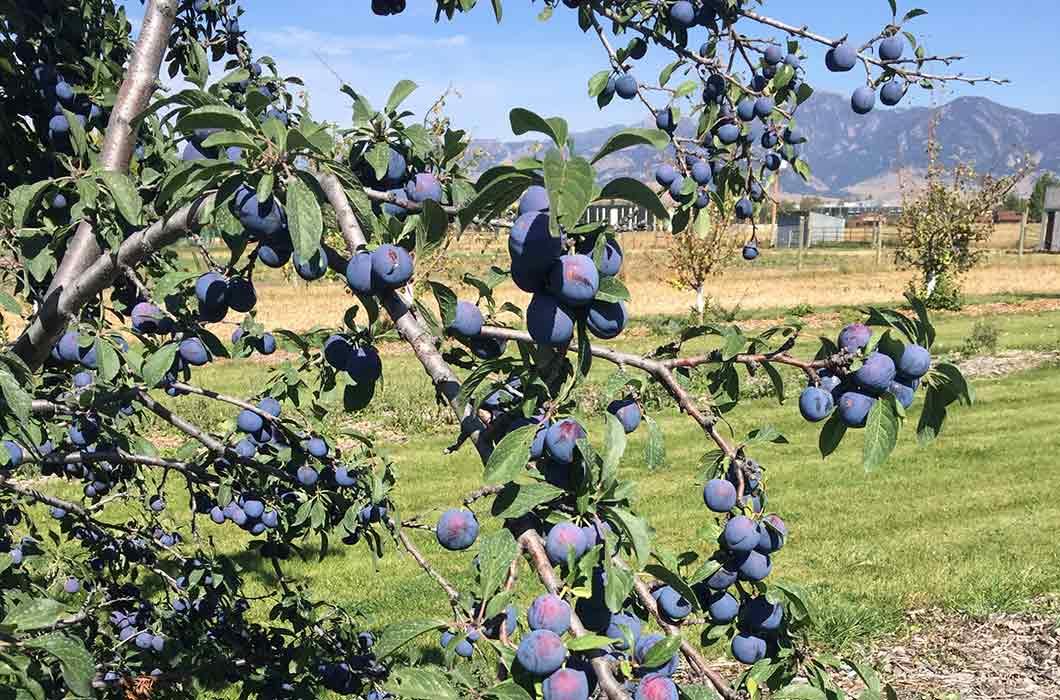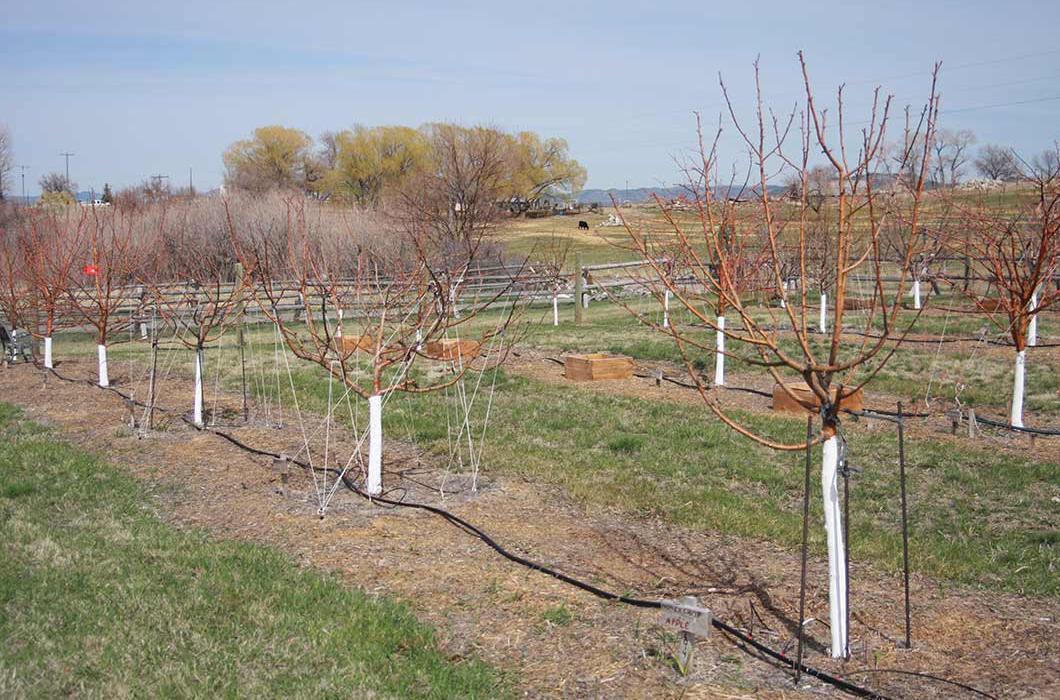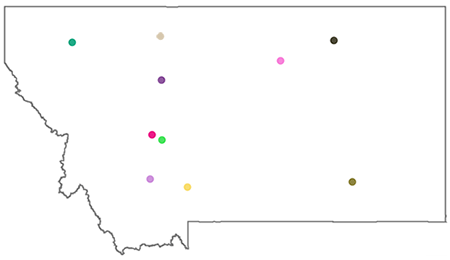MSU Extension Fruit Research Sites
Updated 06/12/2021
Introduction and Background
The following is an edited excerpt from Montana State University-Extension publication EB0222, Growing Fruit Trees in Montana, by Toby Day and Brent Sarchet, 2015.
The Bitterroot and Flathead valleys of Western Montana contain the majority of the fruit production in Montana. In fact, during the 1800s and early 1900s, growers in these regions of shipped fruit all over the country. Montana’s Bitterroot Valley proved conducive to growing apples by early settlers enticed westward by the Homestead Act of 1862. According to the Montana Historical Society, the first commercial apple orchard was planted in the Bitterroot Valley in 1870. The Flathead Lake sweet cherry industry was established in 1895. Sweet cherries and peaches still grow successfully in this microclimate influenced by the "lake effect," which helps prevent killing frost in winter. As the Homestead Act was further expanded in 1909, settlers planted even more orchards near mining towns to supply fruit to the miners. The Montana Heritage Orchard Program works with 70 of the remaining heritage orchards throughout the state.
Commercial fruit production is a void in today's Montana local food systems, with the exception of some regions of Western Montana. Thirty of Montana’s 56 counties (as of 2015) have areas considered food deserts, which impact the ability of low-income individuals in these areas to access fresh, affordable food. (Montana Foodbank Network, 2015). MSU Extension wished to conduct research and develop resources to encourage orchard establishment in some of these food deserts, which are outside of the already fruit-producing Bitterroot and Flathead valleys. In 2012 and 2015, MSU Extension was awarded grants to establish fruit tree cultivar research sites across the state. The ten research sites include: Bozeman, Colstrip, Columbia Falls, Helena, Hinsdale, Lodge Pole, Power, Shelby, Whitehall, and Winston. At each site, apple, pear, plum and sour cherry cultivars are being evaluated.
Current Project Status
The project was transferred to MSU-Western Agricultural Research Center (WARC) in early 2019, following project leads’ departure from MSU. In the spring of 2019, Chase Anderson of MSU-WARC contacted both Extension personnel and private landowners involved with these sites and coordinated visits to collect data regarding plots and trees. Project funding from the Montana Department of Agriculture - Montana Specialty Crop Block Grant ended March 31, 2020. MSU-WARC will continue to coordinate research endeavors (e.g. insect trapping and bloom phenology) with sites and provide site support where possible and appropriate. For more information, please contact Dr. Zach Miller, Assistant Professor-Horticulture at WARC.
Research Highlights
Data analysis is challenging because the sites have different environmental conditions, have been managed differently, and have had many trees replaced over the years. However, tree survival rates provide a commentary regarding cultivars’ robustness to extremes in Montana’s harsh climate. Survival rates averaged across sites and cultivars were 63% for apples, 45% for pears, and 46% for plums.
As of spring 2019, the best-performing cultivars in terms of survival were 'Zestar!' apple and 'Mount Royal' and 'Toka' plum (see Fruit Tree Cultivars, below). Although rootstock is an important consideration that could influence tree survival, this information was not available and so was not considered in the data analyses. As of spring 2019, we can summarize the following:
- Apples: The cultivar 'Northern Lights' had a lower than average survival rate relative to 'Goodland', 'Honeycrisp', 'Frostbite', 'Sweet 16', and 'Zestar!'. 'Zestar!' had better survival rates than average; two site managers noted this variety as a site favorite.
- Pears: There was no statistical difference in survival rates among core pear cultivars 'Golden Spice,' 'Luscious', 'Parker', 'Patten', and 'Ure'. These pear cultivars were selected for the research trial due to their cold tolerance, but less is known about their fire blight resistance. Additionally, one site noted difficulties ripening the fruit: it is unclear whether these pears exhibit typical “summer” vs “winter” ripening. We will explore these questions further as resources (and fruit production) allow.
- Plums: Survival rates were superior for 'Mount Royal' and 'Toka' plum varieties relative to 'Pipestone'. However, plums generally bloom earlier than apples and pears, which could make plums more prone to frost damage. We are planning to collect data on plum bloom timing relative to the other fruit species at two locations this spring (2020).
- Sour cherries: 'Evans Bali' sour cherry was planted at several sites, but not enough sites were represented to analyze survival rates. Note that MSU-WARC has research trials with these and other cold hardy small fruits.
A 2015 project summary is also available, with recommendations for growing fruit trees in Montana. See also this updated list of considerations and resources for growing apple trees.
Fruit Tree Cultivars
Each of the 10 sites has a core group of cultivars replicated at all the sites, with three replications of each cultivar at each site. Sites with additional space have additional cultivars, some of which are replicated at other sites. The core cultivars were selected based upon anecdotal information that they would perform in Montana, and that they could be procured from wholesale growers.
- Apple cultivars planted at all sites: 'Honeycrisp', 'Sweet 16', 'Northern Lights', 'Goodland', and 'Zestar!'
- Pear cultivars planted at all sites: 'Parker', 'Patten', 'Golden Spice', 'Ure', and 'Luscious'
- Plum cultivars planted at all sites: 'Mount Royal', 'Pipestone', and 'Toka'
Cultivar descriptions by Toby Day and Brent Sarchet
Research Site Locations
The map below illustrates over 70 heritage fruit orchards (with trees >75 years old) throughout the state along with the present MSU Extension research sites (diamonds), overlaid on NRCS Montana Rangeland Resource Units and EPA Montana Ecoregions. Click >> to view the legend (scroll down through legend to view all layers), and click on any individual point or polygon to view details. View/download individual orchard layouts and data (Excel spreadsheet) or visit site page to view simplified orchard maps.
Data Analyses
Fruit tree cultivar survival were analyzed separately according to species (apple, pear, and plum), and included only cultivars present at most sites. Survival according to species was tabulated for in contingency tables (number alive vs number dead) and analyzed for “goodness of fit” according to chi-square distribution, where the null hypothesis is that there is no difference between the observed (alive or dead) and expected (alive or dead) frequencies. Where the overall chi-square statistic was significant, post-hoc tests were performed on adjusted residuals (to account for variation in sample size) with Bonferroni’s adjusted p-value for multiple testing comparisons.
- Apples: chi-square test statistic, 12.3; chi-square critical value, 11.1; degrees of freedom, 5; n, 139; p-value, 0.031
- Pears: chi-square test statistic, 8.8; chi-square critical value, 9.5; degrees of freedom, 4; n, 121; p-value, 0.065
- Plums: chi-square test statistic, 26.8; chi-square critical value, 5.9; degrees of freedom, 2; n, 71; p-value, 0.000001
Site Descriptions and Data
Click any site name below to explore details, which are also available in this comprehensive report for all sites (PDF).
Acknowledgements
We would like to thank MSU Extension personnel, site landowners, and site managers for their time and contributions to the project, and Chase Anderson for site visits, data collection, and summaries, and Rebecca Richter for website content creation and management.
This project is funded by a Montana Department of Agriculture Specialty Crop Block Grant.








